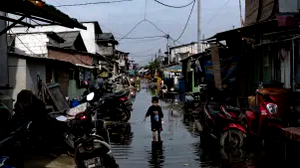Australia’s tropical rainforests will dry out, marine and land heatwaves will become more frequent and intense, and thunderstorms will dump more rain and worsen floods as the globe heats up.
These are among the many impacts from climate change that will blight the nation further unless atmospheric levels of greenhouse gases stabilise, according to the final report of the federal government’s Earth Systems and Climate Change Hub.

|
|
’Hub research has shown a clear link between climate change and
worsening bushfire weather conditions over the past 70 years,” the
centre’s final report finds. Credit: Nick Moir
|
“It’s clear that climate change is already happening and having impacts,” said David Karoly, the leader of the Earth Systems Hub that ended its work on June 30.
Hub achievements include the “massively successful” improvements to the main ACCESS climate model used by Australian governments and agencies to hone future predictions to a smaller scale than before, he said.
|
Extreme weather 
|
|
‘Hazards are many’: Millions found to be at risk from sea level
rise
|
“Higher cloud height, especially during the dry season, could lead to a dry climate that is beyond the tolerance of some species, resulting in rainforest community changes,” the report found, adding “even moderate increases in cloud height were found to have significant implications for cloud-water dependent species”.
Professor Karoly said that, while the lineage of the forests dates back many millions of years, changes were underway in a matter of a hundred years, far faster than species could adapt.
Similarly rapid changes were underway in the oceans around Australia although their remoteness from most people’s experiences meant they were not well known.

|
|
The Tasman Sea is warming at four times the global average,
placing at risk giant kelp forests off the Tasmanian
coast. Credit: Craig Sanderson
|
Key ecosystems, such as the giant kelp forests off Tasmania, are at risk from more frequent heatwaves.
“A marine heatwave [in the Tasman Sea] similar in intensity to those in 2015–16 and 2017–18 is currently expected to occur approximately once every 20 years,” the report said.
“Under [a global] low-emissions scenario, it is expected to occur once every 15 years by the end of the century, and under the high-emissions scenario, a marine heatwave is projected to occur almost every year.”
Marine heatwave days per year
|
|
Source: The Earth Systems and Climate Change Hub
|
At least 35 of them were detected during Black Summer, increasing the risk of erratic winds on unpredictable fire behaviour and ignite new blazes ahead of the fire front, the report noted.
Cumulative observed number of fire-generated thunderstorms
|
|
Source: The Earth Systems and Climate Change Hub
|
The Hub developed new ways to analyse the complex storms and found the most extreme rainfall near eastern Australia was frequently caused by such low-pressure systems combining with a front and a thunderstorm.
The researchers found short-duration events produced by thunderstorms could potentially increase in intensity by about 15 per cent per degree of global warming.

|
|
A line of storms associated with an east coast low sweeping over
the Hawkesbury River north of Sydney in July 2020. Credit: Nick Moir
|
“I worry about how ill-prepared we are for any climate signal for east coast lows,” he said.
Drone vision of Lake Burrendong in the central-west region of NSW in January 2020 when water levels fell to a couple of per cent of capacity. Credit: Nick Moir
|
Extreme weather 
|
|
Hundreds of deaths as Canadian heatwave shatters records
|
These are triggered by lower-than-average rainfall, accompanied by abnormally high temperatures, a dry atmosphere, clear skies and more sunshine, and can be perilous for crops.
The researchers showed the sudden dry spells could be forecast, and they can happen even in winter.
The outgoing Hub cost $23.4 million, with matching contributions from CSIRO, the Bureau of Meteorology and five universities including the University of Melbourne and the University of NSW.
|
Bushfires 
|
|
Storms, tornadoes and explosions: How bushfires are getting
stranger |
While welcomed, “we are not investing remotely enough given the scale of the risk”, Professor Pitman said, adding the new funding was “not even one year’s salary of a top soccer player”.
Simon Marsland, a CSIRO senior scientist who will lead the new Climate Systems Hub, said how communities could adapt to the warming impacts still to come will be one priority as will efforts to work closely with Indigenous populations that are often particularly exposed to extreme weather.
Dr Marsland noted the current record-shattering heatwave in Canada, with near 50-degree temperatures recorded even at a latitude as far as 50 degrees north, were “a good reminder that climate change is here now and not something in the far future”.
Links
- Earth Systems and Climate Change Hub
- Climate change in a land of extremes: Earth Systems and Climate Change Hub
- Australian Community Climate and Earth System Simulator (ACCESS)
- Bushfires, heatwaves storms and floods: climate change report’s dire predictions
- Storms, tornadoes and explosions: How bushfires are getting strange
- Climate change made Australia’s devastating fire season 30% more likely
- Droughts, heatwaves and floods: How to tell when climate change is to blame
- Pinning extreme weather on climate change is now routine and reliable science


No comments :
Post a Comment